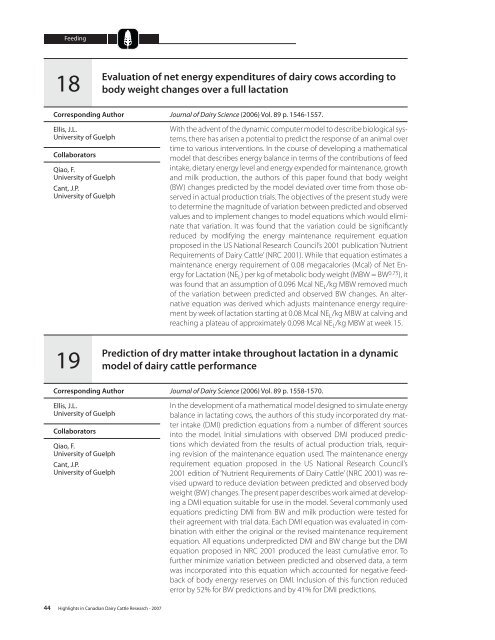A52-75-2007E.pdf - AgroMedia International Inc
A52-75-2007E.pdf - AgroMedia International Inc
A52-75-2007E.pdf - AgroMedia International Inc
Create successful ePaper yourself
Turn your PDF publications into a flip-book with our unique Google optimized e-Paper software.
Feeding18Evaluation of net energy expenditures of dairy cows according tobody weight changes over a full lactationCorresponding AuthorEllis, J.L.University of GuelphCollaboratorsQiao, F.University of GuelphCant, J.P.University of GuelphJournal of Dairy Science (2006) Vol. 89 p. 1546-1557.With the advent of the dynamic computer model to describe biological systems,there has arisen a potential to predict the response of an animal overtime to various interventions. In the course of developing a mathematicalmodel that describes energy balance in terms of the contributions of feedintake, dietary energy level and energy expended for maintenance, growthand milk production, the authors of this paper found that body weight(BW) changes predicted by the model deviated over time from those observedin actual production trials. The objectives of the present study wereto determine the magnitude of variation between predicted and observedvalues and to implement changes to model equations which would eliminatethat variation. It was found that the variation could be significantlyreduced by modifying the energy maintenance requirement equationproposed in the US National Research Council’s 2001 publication ‘NutrientRequirements of Dairy Cattle’ (NRC 2001). While that equation estimates amaintenance energy requirement of 0.08 megacalories (Mcal) of Net Energyfor Lactation (NE L ) per kg of metabolic body weight (MBW = BW 0.<strong>75</strong> ), itwas found that an assumption of 0.096 Mcal NE L /kg MBW removed muchof the variation between predicted and observed BW changes. An alternativeequation was derived which adjusts maintenance energy requirementby week of lactation starting at 0.08 Mcal NE L /kg MBW at calving andreaching a plateau of approximately 0.098 Mcal NE L /kg MBW at week 15.19Prediction of dry matter intake throughout lactation in a dynamicmodel of dairy cattle performanceCorresponding AuthorEllis, J.L.University of GuelphCollaboratorsQiao, F.University of GuelphCant, J.P.University of GuelphJournal of Dairy Science (2006) Vol. 89 p. 1558-1570.In the development of a mathematical model designed to simulate energybalance in lactating cows, the authors of this study incorporated dry matterintake (DMI) prediction equations from a number of different sourcesinto the model. Initial simulations with observed DMI produced predictionswhich deviated from the results of actual production trials, requiringrevision of the maintenance equation used. The maintenance energyrequirement equation proposed in the US National Research Council’s2001 edition of ‘Nutrient Requirements of Dairy Cattle’ (NRC 2001) was revisedupward to reduce deviation between predicted and observed bodyweight (BW) changes. The present paper describes work aimed at developinga DMI equation suitable for use in the model. Several commonly usedequations predicting DMI from BW and milk production were tested fortheir agreement with trial data. Each DMI equation was evaluated in combinationwith either the original or the revised maintenance requirementequation. All equations underpredicted DMI and BW change but the DMIequation proposed in NRC 2001 produced the least cumulative error. Tofurther minimize variation between predicted and observed data, a termwas incorporated into this equation which accounted for negative feedbackof body energy reserves on DMI. <strong>Inc</strong>lusion of this function reducederror by 52% for BW predictions and by 41% for DMI predictions.44 Highlights in Canadian Dairy Cattle Research - 2007





